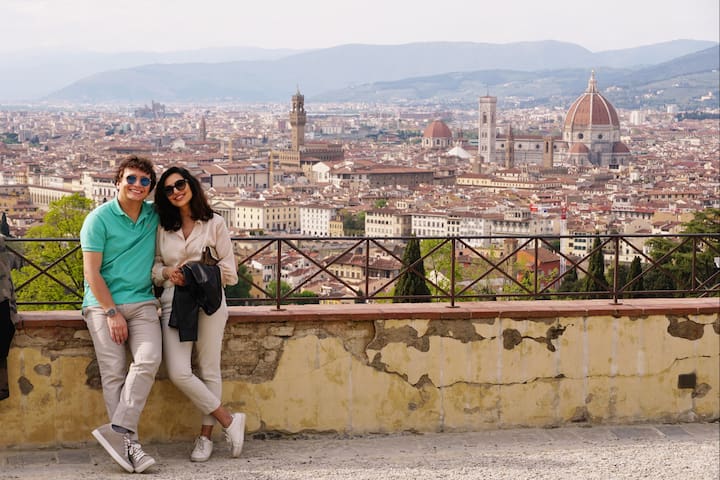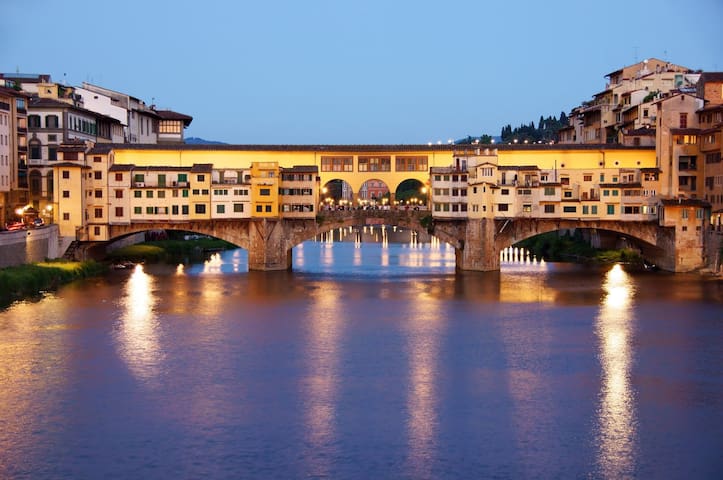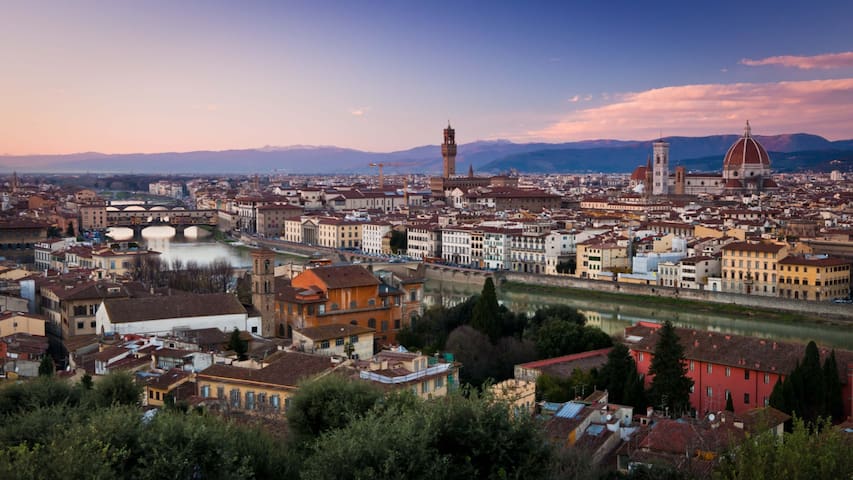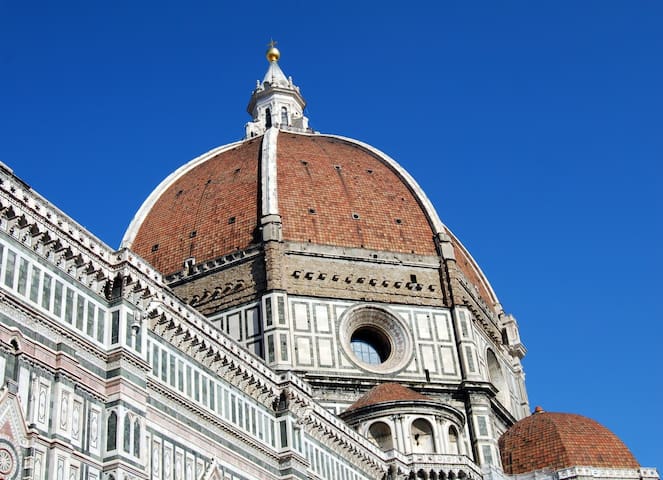Sightseeing
HOME TO MANY MASTERPIECES OF RENAISSANCE ART AND ARCHITECTURE
No one plans a visit to Tuscany without planning a visit to Florence: the city of the lily is a treasure trove of artistic treasures and the centre of a fervent vitality. Aside from its exceptional heritage of art, bearing witness to its centuries of civilisation, Florence can be enjoyed in so many ways: promenading along the enchanting riverbanks at sunset, entering the bohemian alleys of the Oltrarno, or getting lost in the narrow streets of San Niccolò, where walking by the old city walls will leave you feeling as though you have been magically transported into another era.
1943 ντόπιοι το προτείνουν
Φλωρεντία
HOME TO MANY MASTERPIECES OF RENAISSANCE ART AND ARCHITECTURE
No one plans a visit to Tuscany without planning a visit to Florence: the city of the lily is a treasure trove of artistic treasures and the centre of a fervent vitality. Aside from its exceptional heritage of art, bearing witness to its centuries of civilisation, Florence can be enjoyed in so many ways: promenading along the enchanting riverbanks at sunset, entering the bohemian alleys of the Oltrarno, or getting lost in the narrow streets of San Niccolò, where walking by the old city walls will leave you feeling as though you have been magically transported into another era.
Ponte Vecchio is one of Florence’s landmarks and certainly the most photographed bridge in the city. The most famous bridge of them all was built at the narrowest point of the Arno and is the only remaining one with houses and shops on it.
In part this is because something important was built on top of them: the Vasari Corridor. This “secret” passageway, built by Vasari for Duke Cosimo I de’ Medici in 1565, links Palazzo Vecchio to Pitti Palace. In 1593, the jewelry stores that tourists so love were brought to the bridge on command of Ferdinando, the Medici heir who thought that the previous tenants – butchers – smelled too bad to have their shops right below his corridor.
1339 ντόπιοι το προτείνουν
Γέφυρα του Πόντε Βέκιο
Ponte VecchioPonte Vecchio is one of Florence’s landmarks and certainly the most photographed bridge in the city. The most famous bridge of them all was built at the narrowest point of the Arno and is the only remaining one with houses and shops on it.
In part this is because something important was built on top of them: the Vasari Corridor. This “secret” passageway, built by Vasari for Duke Cosimo I de’ Medici in 1565, links Palazzo Vecchio to Pitti Palace. In 1593, the jewelry stores that tourists so love were brought to the bridge on command of Ferdinando, the Medici heir who thought that the previous tenants – butchers – smelled too bad to have their shops right below his corridor.
The Uffizi Galleries in Florence is one of the most important and best-known museums in the world. Located in a palace built by Giorgio Vasari in 1560 on the orders of Cosimo I de’ Medici, the museum is home not only to masterpieces of the Italian Renaissance, but also works by German, Flemish, Dutch and French masters.
Among the most recognized artists, we find works by Cimabue, Giotto and Duccio di Buoninsegna, as well as some by the great Sienese artists of the 14th century, Simone Martini and the brothers Piero and Ambrogio Lorenzetti. Followers of the Giotto school are also on display inside the Galleries.
But the true symbol of the Uffizi in Florence is the artist Sandro Botticelli, whose most emblematic works are on high display: The Birth of Venus, Primavera, the Madonna of the Magnificat and the Madonna of the Pomegranate.
Leonardo da Vinci‘s masterpieces are equally glorious, such as The Baptism of Christ, which he executed alongside his master Verrocchio, the Adoration of the Magi and the Annunciation, made early in the artist’s career. There’s also Mantegna’s Triptych of the Uffizi, works by Perugino, Signorelli and Piero di Cosimo, and even the monumental Battle of San Romano by Paolo Uccello.
Pontormo, Giorgione, Tintoretto and Correggio are just some of the other grand masters on display in the Uffizi. Plus there are the countless European masters, such as El Greco, Velasquez and Goya, in addition to Rembrandt, Hans Memling, Rubens and Dürer.
The most famous paintings include the double Portrait of the Dukes of Urbino by Piero della Francesca, the fragile Madonna del Cardellino by Raphael, masterpieces by Caravaggio, like Bacchus and the petrifying Medusa.
We mustn’t forget Michelangelo‘s extraordinary Tondo Doni, Titian‘s Venus
Accessibility information: uffizi.it
1671 ντόπιοι το προτείνουν
Πινακοθήκη των Ουφίτσι
6 Piazzale degli UffiziThe Uffizi Galleries in Florence is one of the most important and best-known museums in the world. Located in a palace built by Giorgio Vasari in 1560 on the orders of Cosimo I de’ Medici, the museum is home not only to masterpieces of the Italian Renaissance, but also works by German, Flemish, Dutch and French masters.
Among the most recognized artists, we find works by Cimabue, Giotto and Duccio di Buoninsegna, as well as some by the great Sienese artists of the 14th century, Simone Martini and the brothers Piero and Ambrogio Lorenzetti. Followers of the Giotto school are also on display inside the Galleries.
But the true symbol of the Uffizi in Florence is the artist Sandro Botticelli, whose most emblematic works are on high display: The Birth of Venus, Primavera, the Madonna of the Magnificat and the Madonna of the Pomegranate.
Leonardo da Vinci‘s masterpieces are equally glorious, such as The Baptism of Christ, which he executed alongside his master Verrocchio, the Adoration of the Magi and the Annunciation, made early in the artist’s career. There’s also Mantegna’s Triptych of the Uffizi, works by Perugino, Signorelli and Piero di Cosimo, and even the monumental Battle of San Romano by Paolo Uccello.
Pontormo, Giorgione, Tintoretto and Correggio are just some of the other grand masters on display in the Uffizi. Plus there are the countless European masters, such as El Greco, Velasquez and Goya, in addition to Rembrandt, Hans Memling, Rubens and Dürer.
The most famous paintings include the double Portrait of the Dukes of Urbino by Piero della Francesca, the fragile Madonna del Cardellino by Raphael, masterpieces by Caravaggio, like Bacchus and the petrifying Medusa.
We mustn’t forget Michelangelo‘s extraordinary Tondo Doni, Titian‘s Venus
Accessibility information: uffizi.it
Piazzale Michelangelo is where you can get the most famous view of Florence, a magnificent terrace overlooking the city, named after one of the most important Florentine artists of the Renaissance: Michelangelo Buonarroti. It can be reached from viale Galileo, viale Michelangiolo or from Piazza Poggi climbing the famous stairs known as the Rampe del Poggi.
Construction of the piazzale was part of Florence’s urban renewal when it was named capital of Italy, beginning in 1873 and opened two years later. According to the designs of the architect, Giuseppe Poggi, the entire piazzale was to become a shrine to Michelangelo: even the Neoclassical loggia was proposed as a museum where all the great artist’s works in Florence would be on display. In the end, the museum idea was scrapped and in 1876, the loggia became a restaurant-café.
In the middle of the piazza there is a monument made up of bronze copies of some of Michelangelo’s works: the four allegories from the Medici chapel in San Lorenzo and the famous David, with his gaze directed towards the hills on the other side of the city.
The piazzale is an excellent panoramic terrace over Florence, a favourite spot for citizens and tourists who want to take in all of Florence’s beauty from an evocative place.
1543 ντόπιοι το προτείνουν
Πιατσάλε Μικελάντζελο
Piazzale MichelangeloPiazzale Michelangelo is where you can get the most famous view of Florence, a magnificent terrace overlooking the city, named after one of the most important Florentine artists of the Renaissance: Michelangelo Buonarroti. It can be reached from viale Galileo, viale Michelangiolo or from Piazza Poggi climbing the famous stairs known as the Rampe del Poggi.
Construction of the piazzale was part of Florence’s urban renewal when it was named capital of Italy, beginning in 1873 and opened two years later. According to the designs of the architect, Giuseppe Poggi, the entire piazzale was to become a shrine to Michelangelo: even the Neoclassical loggia was proposed as a museum where all the great artist’s works in Florence would be on display. In the end, the museum idea was scrapped and in 1876, the loggia became a restaurant-café.
In the middle of the piazza there is a monument made up of bronze copies of some of Michelangelo’s works: the four allegories from the Medici chapel in San Lorenzo and the famous David, with his gaze directed towards the hills on the other side of the city.
The piazzale is an excellent panoramic terrace over Florence, a favourite spot for citizens and tourists who want to take in all of Florence’s beauty from an evocative place.
This piazza has always represented the political heart of Florence. As soon as you arrive, you will notice its unusual L-shape, a configuration that dates back to the second half of the thirteenth century, when the Guelf party, having regained control of the city, decided to raze to the ground the 36 buildings in the square that belonged to their Ghibelline rivals. Hence its peculiar shape.
In Piazza della Signoria you will see the Palazzo Vecchio, the Loggia dei Lanzi and Neptune’s Fountain. The first of these has served as the city hall for centuries: indeed between 1865 and 1871 it was the Parliament building of the newborn Kingdom of Italy. The palazzo has not always borne its current name, but has variously been known as the Palazzo dei Priori, Palazzo della Signoria and the Palazzo Ducale, before being definitively named the Palazzo Vecchio in 1565, when Duke Cosimo I moved his court to the Palazzo Pitti. A great many artists have worked on its interiors over the centuries, embellishing it with precious works of art: Bronzino, Ghirlandaio, Giorgio Vasari, Michelangelo, Donatello and Verrocchio, to name just a few. Having undergone extensive restructuring, it today functions as Florence’s town hall.
Opposite the Palazzo Vecchio we find the Loggia dei Lanzi, a true outdoor museum, where you can admire masterpieces like Benvenuto Cellini’s Perseus and Giambologna’s Rape of the Sabine Women.
Staying in the piazza, it is impossible not to be enchanted by Neptune’s Fountain, designed by Bartolomeo Ammannati and inaugurated in 1565 to mark the wedding between Francesco I de’ Medici and Grand Duchess Joanna of Austria. Inside the Palazzo Vecchio you can still read a plague, dated 1720, that gives the rules for using the fountain. It is forbidden, it reads, “to dirty the fountain in any way, to wash inkpots, clothes or anything else in it, or to dispose of timber or other waste.” A little insight into the customs of times past.
A few steps from the Piazza della Signoria, you should walk across the Ponte Vecchio, one of the symbols of the city and the oldest of the bridges that span the River Arno. Its first incarnation was probably erected during the Roman period, but it was rebuilt in 1345 by either Taddeo Gaddi or Neri di Fioravante. Ever since 1593 the bridge has been home to the city’s jewellers and goldsmiths, which makes the Ponte Vecchio the perfect venue for a day of shopping.
557 ντόπιοι το προτείνουν
Πιάτσα ντέλα Σινιόρια
Piazza della SignoriaThis piazza has always represented the political heart of Florence. As soon as you arrive, you will notice its unusual L-shape, a configuration that dates back to the second half of the thirteenth century, when the Guelf party, having regained control of the city, decided to raze to the ground the 36 buildings in the square that belonged to their Ghibelline rivals. Hence its peculiar shape.
In Piazza della Signoria you will see the Palazzo Vecchio, the Loggia dei Lanzi and Neptune’s Fountain. The first of these has served as the city hall for centuries: indeed between 1865 and 1871 it was the Parliament building of the newborn Kingdom of Italy. The palazzo has not always borne its current name, but has variously been known as the Palazzo dei Priori, Palazzo della Signoria and the Palazzo Ducale, before being definitively named the Palazzo Vecchio in 1565, when Duke Cosimo I moved his court to the Palazzo Pitti. A great many artists have worked on its interiors over the centuries, embellishing it with precious works of art: Bronzino, Ghirlandaio, Giorgio Vasari, Michelangelo, Donatello and Verrocchio, to name just a few. Having undergone extensive restructuring, it today functions as Florence’s town hall.
Opposite the Palazzo Vecchio we find the Loggia dei Lanzi, a true outdoor museum, where you can admire masterpieces like Benvenuto Cellini’s Perseus and Giambologna’s Rape of the Sabine Women.
Staying in the piazza, it is impossible not to be enchanted by Neptune’s Fountain, designed by Bartolomeo Ammannati and inaugurated in 1565 to mark the wedding between Francesco I de’ Medici and Grand Duchess Joanna of Austria. Inside the Palazzo Vecchio you can still read a plague, dated 1720, that gives the rules for using the fountain. It is forbidden, it reads, “to dirty the fountain in any way, to wash inkpots, clothes or anything else in it, or to dispose of timber or other waste.” A little insight into the customs of times past.
A few steps from the Piazza della Signoria, you should walk across the Ponte Vecchio, one of the symbols of the city and the oldest of the bridges that span the River Arno. Its first incarnation was probably erected during the Roman period, but it was rebuilt in 1345 by either Taddeo Gaddi or Neri di Fioravante. Ever since 1593 the bridge has been home to the city’s jewellers and goldsmiths, which makes the Ponte Vecchio the perfect venue for a day of shopping.
We start in Florence’s most famous square. You’ll feel a lot of things upon first setting foot in Piazza del Duomo, just by looking, from any angle, at Brunelleschi’s Dome, a majestic, awe-inspiring view like no other in the world. At the time of its construction it was the biggest on earth, and even today, nearly 600 years later (it was completed in 1436), it remains the largest dome ever made out of brick.
But the cathedral and its dome are not the only things of beauty that you will find in this extraordinary square, for just opposite its steps you will see the Baptistery of San Giovanni. A little jewel of architecture, over the centuries it has seen the christening of knights and poets aplenty. Its origins are shrouded in mystery: it was once thought to have been built on the ruins of an ancient temple of the god Mars, but this theory was abandoned as more archaeological remains were unearthed over the nineteenth century.
Also in Piazza del Duomo stands Giotto’s bell-tower. At almost 85 metres high and 15 metres wide, it is living testimony to the Florentine gothic architecture of the fourteenth century; stand near its base and you will be amazed by the white, red and green marble in which it is clad. As its name suggests, it was begun in 1334 by Giotto, and upon his death was continued under the supervision of Andrea Pisano.
The Baptistery, Giotto’s bell-tower and Brunelleschi’s dome can all be visited. Booking is required for Brunelleschi’s Dome: you specify a time when you buy the ticket.
1085 ντόπιοι το προτείνουν
Cathedral of Santa Maria del Fiore
Piazza del DuomoWe start in Florence’s most famous square. You’ll feel a lot of things upon first setting foot in Piazza del Duomo, just by looking, from any angle, at Brunelleschi’s Dome, a majestic, awe-inspiring view like no other in the world. At the time of its construction it was the biggest on earth, and even today, nearly 600 years later (it was completed in 1436), it remains the largest dome ever made out of brick.
But the cathedral and its dome are not the only things of beauty that you will find in this extraordinary square, for just opposite its steps you will see the Baptistery of San Giovanni. A little jewel of architecture, over the centuries it has seen the christening of knights and poets aplenty. Its origins are shrouded in mystery: it was once thought to have been built on the ruins of an ancient temple of the god Mars, but this theory was abandoned as more archaeological remains were unearthed over the nineteenth century.
Also in Piazza del Duomo stands Giotto’s bell-tower. At almost 85 metres high and 15 metres wide, it is living testimony to the Florentine gothic architecture of the fourteenth century; stand near its base and you will be amazed by the white, red and green marble in which it is clad. As its name suggests, it was begun in 1334 by Giotto, and upon his death was continued under the supervision of Andrea Pisano.
The Baptistery, Giotto’s bell-tower and Brunelleschi’s dome can all be visited. Booking is required for Brunelleschi’s Dome: you specify a time when you buy the ticket.





